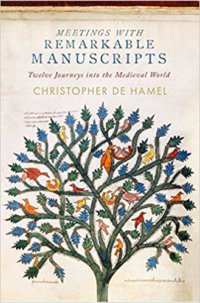Meeting with Remarkable Manuscripts: Twelve Journeys into the Medieval World

Meeting with Remarkable Manuscripts: Twelve Journeys into the Medieval World. Christopher de Hamel. New York: Penguin, 2017.
Meeting with Remarkable Manuscripts is a magnificent achievement in not only revealing to us the beauty, power, and erudition of these twelve works but also introduce us to the medieval world of kings, queens, artists, and collectors. With each manuscript, Hamel traces its genealogy and his personal encounter with it, telling us the manuscript’s condition, weight, smell, marginalia as well as the problems with passing through the various security and academic bureaucracies to see the manuscripts. The account for each manuscript is learned but not academic, accessible yet not simple. When reading Meeting with Remarkable Manuscripts, you feel as if you are a companion with Hamel in his journeys to visit them.
But what makes Meeting with Remarkable Manuscripts exceptional is the colored illustrations in the book that illuminate what Hamel describes for each manuscript. Not only are certain pages of the manuscripts beautifully shown but also important photographs of the places where these manuscripts reside. The combination of the photographs, illustrations, and words paint a world where these medieval manuscripts live and depict Hamel’s encounter with them as he visits various institutions.
Chapter one is on the sixth-century Gospel of Augustine, now in the Parker Library of Corpus Christi College, Cambridge, and introduces us to the medieval period when literacy begins to emerge after the collapse of the Roman Empire. Chapter two is about the Codex Amiatinus (700 AD), housed in Florence’s Bibliotecca Laurenziana, the oldest surviving Latin Bible; while chapter three looks at the eighth-century Book of Kells at Dublin’s Trinity College, which contains the Gospels but portrays them inconsistently when compared to other copies. In the Book of Kells magic and belief are inseparable and the book eventually plays a role in the formation of modern Irish national identity.
Chapters four is about the ninth-century Aratea, residing in Leiden’s Universiteitsbibliotheek, which is a copy of Germanicus’ astronomical treatise, while chapter five is on the tenth-century Morgan Beatus, now at the Morgan Library and Museum in New York City, which is a commentary on the Apocalypse. Chapter six examines the eleventh-century writings and illustrations of Hugo Pictor, kept at Oxford’s Bodleian Library, which recounts the effects of the Norman Conquest of 1066. Chapter seven is on the twelfth-century Copenhagen Psalter, stored at the Kongelge Bibliotek, which Hamel argues was given to King Valdemar the Great rather than to King Canute VI.
Chapter eight is about the Carmina Burana, housed at Bayerische Staatbibliorhek in Munich, which are stories about love and lust of students and scholars in the thirteenth century and later inspires Carl Orff to write his cantata. Chapter nine explores the Bibliothèque nationale de France’s fourteenth-century Hours of Jeanne de Navarre, an illuminated “book of hours” where the day is divided into distinctive cycles of prayers and psalms. Chapter ten is on the fifteenth-century Canterbury Tales, the Hengwrt manuscript at the National Library of Wales, where English literature and language begin to emerge.
Chapter eleven examines St. Petersburg National Library’s Semideus, composed by Catone Sacco (c. 1395-1463) and presented to Filippo Maria Viscontin (1392-1447) in its discussion of warfare and arms. Chapter twelve looks at the J. Paul Getty Museum’s sixteenth-century Spinola Hours, a sixteenth century Flemish manuscript. The book, Meeting with Remarkable Manuscripts, concludes with an extensive and helpful bibliography and notes.
All these manuscripts were written by hand, had illustrations, and generally were not dated or had page numbers. It took several years, if not generations, to write these manuscripts and often were done by groups of people, resulting in gaps in the texts or cycle of pictures. Whereas this might bother the modern scholar, this was not so important to the medieval mind, for manuscripts were a communal effort of a shared culture.
Reading about these manuscripts, and their histories of how they ended up where they are now, brings attention to the role of luck in preserving these manuscripts. As Hamel notes, “Of the twelve items interviewed here, only one – the House of Jeanne de Navarre – is preserved today in the country where it was actually made, at least as defined by modern political boundaries” (567). In contrast to the information overload of words, images, and videos in our own day, medieval manuscripts were rare and therefore more precious and personal. They were created by individuals rather than machines and thereby reflect the idiocrasies of their authors, places, and times. Each manuscript has its own unique personality and in a sense is an animate thing when we encounter them.
Meeting with Remarkable Manuscripts lives up to its title as being remarkable: it captures the personalized encounter we have with books and thereby change how we see them afterwards. It is a fascinating and informative journey of the histories of these manuscripts. Superbly illustrated, Meeting with Remarkable Manuscripts is a wonderful way to read about books and why they matter.




